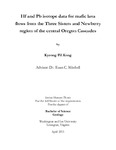| dc.rights.license | In Copyright | en_US |
| dc.creator | Kong, Kyeong Pil (Phil) | |
| dc.date.accessioned | 2015-07-29T17:55:06Z | |
| dc.date.available | 2015-07-29T17:55:06Z | |
| dc.date.created | 2015 | |
| dc.identifier | WLURG38_Kong_GEOL_2015 | |
| dc.identifier.uri | http://hdl.handle.net/11021/32161 | |
| dc.description | Thesis; [FULL-TEXT FREELY AVAILABLE ONLINE] | en_US |
| dc.description | Kyeong Pil (Phil) Kong is a member of the Class of 2015 of Washington and Lee University. | en_US |
| dc.description.abstract | The Cascade arc is an end member convergent margin in which the young and slowly subducting slab is hotter than in most subduction zones. Consequently, the timing and location of slab contribution, namely dehydration, is impacted and ultimately affects the generation of magma in the overlying mantle. In order to constrain the extent of involvement of slab-derived components such as the subducting altered oceanic crust (AOC), sediments, and hydrated mantle lithosphere, radiogenic isotope ratios of mafic lava flow samples of interest were measured and modeled as mixtures of these end-members.
Prior work has measured major and trace elements, U-series (U-Th-Ra-Pa), and Sr-Nd isotopes from mafic lava flow samples from the Three Sisters volcano region (main-arc) and the Newberry Volcanic Field (back-arc) at the University of New Mexico -- Earth and Planetary Sciences. These analyses indicate limited involvement of subducted sediments during magma generation.
Pb and Hf isotope data were collected on the same mafic lava flow samples from the previous work mentioned above. Ranges in Pb and Hf ratios, the first Hf data from the Oregon Cascades, are consistent with existing Cascade arc data . . . The most primitive lavas define a narrower range of 176Hf/177Hf values, with Hf > 10.28. The most primitive lavas also define narrower ranges in Pb isotope ratios, intermediate between the Three Sisters and Newberry basaltic andesites.
Slab component models were created for Sr, Nd, Pb, and Hf isotopes; using elemental and isotopic values for Juan de Fuca MORB to represent a homogeneous mantle end member and data from ODP and DSDP drill sites on the Juan de Fuca plate to represent the sediment end member in the modeling systems. A variety of modeling scenarios suggest that the most likely slab contribution process is dehydration at relatively warm temperatures followed by a melting episode of the subducting sediments at higher temperatures. . . . Analysis of accessory phases in the melt residue qualitatively reaffirms the observations made from the slab component mixing models, indicating that volcanism in the central Oregon Cascade arc is driven by dehydration of the slab and melting of the subducting sediments at high temperatures. | en_US |
| dc.format.extent | 46 pages | en_US |
| dc.language.iso | en_US | en_US |
| dc.rights | This material is made available for use in research, teaching, and private study, pursuant to U.S. Copyright law. The user assumes full responsibility for any use of the materials, including but not limited to, infringement of copyright and publication rights of reproduced materials. Any materials used should be fully credited with the source. | en_US |
| dc.rights.uri | http://rightsstatements.org/vocab/InC/1.0/ | en_US |
| dc.subject.other | Washington and Lee University -- Honors in Geology | en_US |
| dc.title | Hf and Pb Isotope Data for Mafic Lava Flows from the Three Sisters and Newberry Regions of the Central Oregon Cascades (thesis) | en_US |
| dc.type | Text | en_US |
| dcterms.isPartOf | RG38 - Student Papers | |
| dc.rights.holder | Kong, Kyeong Pil (Phil) | |
| dc.subject.fast | Lava flows | en_US |
| dc.subject.fast | Oregon -- Three Sisters | en_US |
| dc.subject.fast | Oregon -- Newberry Volcano | en_US |
| dc.subject.fast | Isotope geology | en_US |
| dc.subject.fast | Geological modeling -- Computer simulation | en_US |
| local.department | Geology | en_US |
| local.scholarshiptype | Honors Thesis | en_US |
